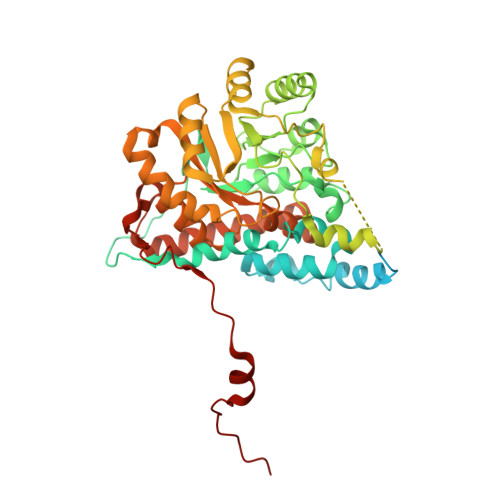Altered Substrate Specificity in Flavocytochrome b(2): Structural Insights into the Mechanism of l-Lactate Dehydrogenation
Mowat, C.G., Wehenkel, A., Green, A.J., Walkinshaw, M.D., Reid, G.A., Chapman, S.K.(2004) Biochemistry 43: 9519-9526
- PubMed: 15260495
- DOI: https://doi.org/10.1021/bi049263m
- Primary Citation of Related Structures:
1SZE, 1SZF, 1SZG - PubMed Abstract:
Flavocytochrome b(2) from Saccharomyces cerevisiae is a l-lactate/cytochrome c oxidoreductase belonging to a large family of 2-hydroxyacid-dependent flavoenzymes. The crystal structure of the enzyme, with pyruvate bound at the active site, has been determined [Xia, Z.-X., and Mathews, F. S. (1990) J. Mol. Biol. 212, 837-863]. The authors indicate that the methyl group of pyruvate is in close contact with Ala198 and Leu230. These two residues are not well-conserved throughout the family of (S)-2-hydroxy acid oxidases/dehydrogenases. Thus, to probe substrate specificity in flavocytochrome b(2), these residues have been substituted by glycine and alanine, respectively. Kinetic studies on the L230A mutant enzyme and the A198G/L230A double mutant enzyme indicate a change in substrate selectivity for the enzyme toward larger (S)-2-hydroxy acids. In particular, the L230A enzyme is more efficient at utilizing (S)-2-hydroxyoctanoate by a factor of 40 as compared to the wild-type enzyme [Daff, S., Manson, F. D. C., Reid, G. A., and Chapman, S. K. (1994) Biochem. J. 301, 829-834], and the A198G/L230A double mutant enzyme is 6-fold more efficient with the aromatic substrate l-mandelate than it is with l-lactate [Sinclair, R., Reid, G. A., and Chapman, S. K. (1998) Biochem. J. 333, 117-120]. To complement these solution studies, we have solved the structure of the A198G/L230A enzyme in complex with pyruvate and as the FMN-sulfite adduct (both to 2.7 A resolution). We have also obtained the structure of the L230A mutant enzyme in complex with phenylglyoxylate (the product of mandelate oxidation) to 3.0 A resolution. These structures reveal the increased active-site volume available for binding larger substrates, while also confirming that the integrity of the interactions important for catalysis is maintained. In addition to this, the mode of binding of the bulky phenylglyoxylate at the active site is in accordance with the operation of a hydride transfer mechanism for substrate oxidation/flavin reduction in flavocytochrome b(2), whereas a mechanism involving the formation of a carbanion intermediate would appear to be sterically prohibited.
Organizational Affiliation:
School of Chemistry, University of Edinburgh, West Mains Road, Edinburgh EH9 3JJ, United Kingdom.
















